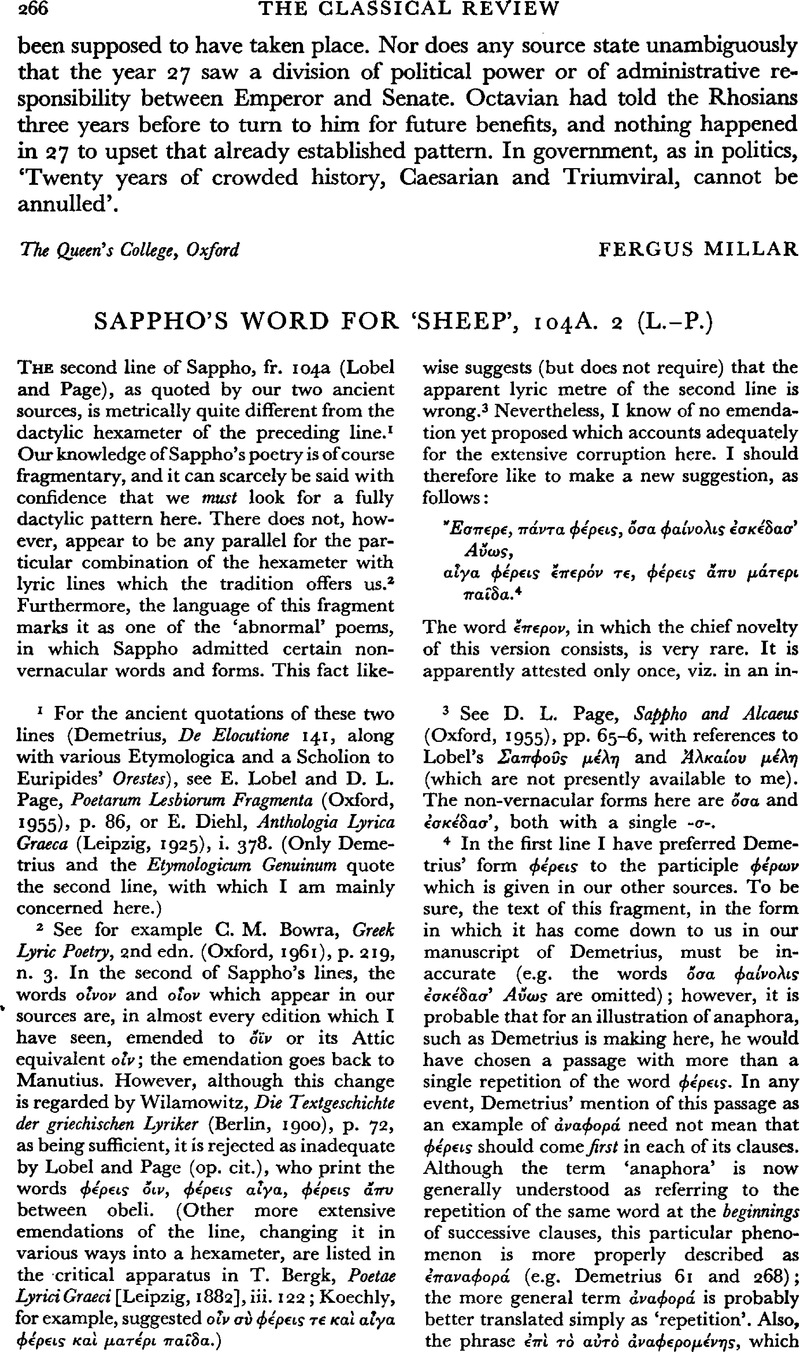No CrossRef data available.
Article contents
Sappho's word for ‘sheep’, 104A. 2 (L.–P.)
Published online by Cambridge University Press: 27 February 2009
Abstract

- Type
- Review Article
- Information
- Copyright
- Copyright © The Classical Association 1968
References
page 266 note 1 For the ancient quotations of these two lines (Demetrius, De Elocutione 141, along with various Etymologica and a Scholion to Euripides' Orestes), see Lobel, E. and Page, D. L., Poetarum Lesbiorum Fragmenta (Oxford, 1955), p. 86Google Scholar, or Diehl, E., Anthologia Lyrica Graeca (Leipzig, 1925), i. 378Google Scholar. (Only Demetrius and the Etymologicum Genuinum quote the second line, with which I am mainly concerned here.)
page 266 note 2 See for example Bowra, C. M., Greek Lyric Poetry, 2nd edn. (Oxford, 1961), p. 219, n. 3Google Scholar. In the second of Sappho's lines, the words οἰνον and οἱον which appear in our sources are, in almost every edition which I have seen, emended to ⋯ïν or its Attic equivalent οἰν; the emendation goes back to Manutius. However, although this change is regarded by Wilamowitz, , Die Textgeschichte der griechischen Lyriker (Berlin, 1900), p. 72Google Scholar, as being sufficient, it is rejected as inadequate by Lobel and Page (op. cit.), who print the words φ⋯ρεις ⋯ιν, φ⋯ρεις αἰγα, φ⋯ρεις ἄπυ between obeli. (Other more extensive emendations of the line, changing it in various ways into a hexameter, are listed in the critical apparatus in Bergk, T., Poetae Lyrici Graeci [Leipzig, 1882], iii. 122Google Scholar; Koechly, for example, suggested οἶν σὺ φ⋯ρεις τε κα⋯ αἶγα φ⋯ρεις κα⋯ ματ⋯ρι παῖδα.)
page 266 note 3 See Page, D. L., Sappho and Alcaeus (Oxford, 1955), pp. 65–66Google Scholar, with references to Lobel's Σαπφο⋯ς μ⋯λη and Ἀλκα⋯ου μ⋯λη (which are not presently available to me). The non-vernacular forms here are ⋯σα and ⋯σκ⋯δασ', both with a single -σ-.
page 266 note 4 In the first line I have preferred Demetrius' form φ⋯ρεις to the participle φ⋯ρων which is given in our other sources. To be sure, the text of this fragment, in the form in which it has come down to us in our manuscript of Demetrius, must be inaccurate (e.g. the words ⋯σα φα⋯νολις ⋯σκ⋯δασ' Αὔως are omitted); however, it is probable that for an illustration of anaphora, such as Demetrius is making here, he would have chosen a passage with more than a single repetition of the word φ⋯ρεις. In any event, Demetrius' mention of this passage as an example of ⋯ναφορ⋯ need not mean that φ⋯ρεις should come first in each of its clauses. Although the term ‘anaphora’ is now generally understood as referring to the repetition of the same word at the beginnings of successive clauses, this particular phenomenon is more properly described as ⋯παναφορ⋯ (e.g. Demetrius 61 and 268); the more general term ⋯ναφορ⋯ is probably better translated simply as ‘repetition’. Also, the phrase ⋯π⋯ τ⋯ αὐτ⋯ ⋯ναφερομ⋯νης, which Demetrius here uses to describe more fully Sappho's use of the word φ⋯ρεις, probably does not refer to a repetition of the word in exactly the same position in each phrase. Rather, it would seem to mean ‘being repeated with the same meaning’; cf. W. Rhys Roberts's translation (‘repetition …, which has the same reference throughout’), in his translation of Demetrius in the Loeb series (1932). PP. 391 and 393.
page 267 note 1 For the Aegae inscription see Reinach, S., ‘Deux Inscriptions de l'Asie-Mineure’, R.ε.G. iv (1891), 268–275Google Scholar, and Schwyzer, E., Dialectorum Graecarum exempla epigraphica potiora (Leipzig, 1923), p. 307Google Scholar. For the derivation ⋯π-ερος, see Schwyzer, E., Griechische Grammatik (Munich, 1959), i. 435Google Scholar, where the compound is glossed as ‘wo Wolle darauf ist, Schaf’; cf. the gloss ‘sheep’ given by Buck, C. D., The Greek Dialects (Chicago, probably 1955), P. 149Google Scholar. (Tne entry in L.S.J., s.v. ἔπερος, is misleading, both with regard to the provenience of the inscription and with regard to the meaning of the word.)
page 267 note 2 The fact that non-vernacular elements were allowed in this poem is not, I feel, any barrier to Sappho's having here used a word which must have been of geographically quite restricted occurrence. Cf. Page (op. cit.), p. 71, n. 5, for a listing of the various innovations which appear side by side with Homeric features in fr. 44, the best-preserved of the ‘abnormal’ poems. Also, it may be noted that in fr. 105a (possibly from the same poem as our fragment, see Page, pp. 121–2), the word μαλοδρ⋯πηες, despite the transparency of its formation, is actually extremely rare; at least, no other citation is given in L.S.J. for it or for μηλοδροπε⋯ς.


